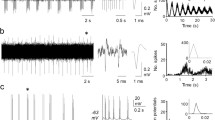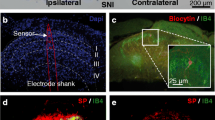Abstract
In experiments on rabbits anesthetized with urethane, we recorded spontaneous sympathetic activity of single nerve fibers. The activity was recorded from fine filaments dissected from the cervical sympathetic nerve trunk (CSNT). Conduction velocities in CSNT fibers and action-potential amplitude of single B-fibers were measured during recording of whole nerve trunk. Spectral analysis of the activity recorded was carried out. It was shown that unmyelinated CSNT fibers are under stronger baroreceptor control than myelinated fibers. Also, a periodic component of 2–3 Hz, noted by a number of authors after denervation of baroreceptors, was detected in intact animals along with a rhythm at the pulse rate. This component was found equally often in the activity of B- and C-fibers. Cross-correlation analysis of the simultaneously recorded activities of 24 pairs of CSNT single fibers was carried out. A correlation due to synchronization of the activities of pairs of fibers with a physiological rhythm (respiration, pulse) was found in five pairs. The correlation in one pair suggests the presence of a common excitatory synaptic input into two distinct preganglionic neurons.
Similar content being viewed by others
Literature cited
R. M. Meshcherskiy, The Analysis of Neuronal Activity [in Russian], Nauka, Moscow (1972).
S. L. Purnyn', "Spontaneous sympathetic activity in the sciatic nerve of the rabbit," Neirofiziologiya,17, No. 3, 351–358 (1985).
S. L. Purnyn', and S. V. Voitenko, "Rhythmic components of integral spontaneous activity of sympathetic nerves," Neirofiziologiya,23, No. 3, 266–273 (1991).
I. N. Remizov and V. I. Skok, "Investigation of spontaneous activity of cervical sympathetic nerve of rabbit using cross-correlation technique," in: Central and Peripheral Mechanisms of the Vegetative Nervous Systems [in Russian], Ervan, ArmSSR (1985), pp. 157–160.
V. I. Skok and A. Ya. Ivanov, "Two preganglionic inputs of a sympathetic neuron," Dokl. Akad. Nauk SSSR, Ser. B., No. 7, 77–79 (1982).
V. I. Skok and A. Ya. Ivanov, The Natural Activity of Vegetative Ganglia [in Russian], Nauka Dumka, Kiev (1989).
E. D. Adrian, D. W. Bronk, and G. Phillips, "Discharges in mammalian sympathetic nerves," J. Physiol.,74, No. 1, 115–133 (1932).
H. Camerer, M. Stroh-Werz, B. Kreinde, and P. Langhorst, "Preganglionic sympathetic activity with correlation to heart rhythm and central cortical rhythms," Pflügers Arch.,370, No. 3, 221–225 (1977).
M. I. Cohen and P. M. Gootman, "Periodicities in efferent discharge of splanchnic nerve of the cat," Am. J. Physiol.,218, No. 4, 1092–1101 (1970).
J. O. Foley and F. DuBois, "A quantitative and experimental study of the cervical sympathetic trunk," J. Comp. Neurol.,72, No. 3, 587–798 (1940).
A. S. French, "A sampling algorithm for bandwidth limitation of action potential trains," in: Computer Technology in Neuroscience, P. B. Brown (ed.), New York (1978), pp. 447–458.
G. H. Green and P. F. Heffron, "Observations on the origin and genesis of a rapid sympathetic rhythm," Arch. Int. Pharmacodyn.,169, No. 3, 403–411 (1967).
M. Gregor, W. Janig, and L. Wipruch, "Cardiac and respiratory rhythmicities in cutaneous and muscle vasoconstrictor neurons to the cat's hindlimb," Pflügers Arch.,370, No. 3, 299–302 (1977).
A. Iggo and M. Vogt, "Preganglionic sympathetic activity in normal and in reserpine treated cats," J. Physiol.,150, No. 1, 114–133 (1960).
W. Janig and R. F. Schmidt, "Single unit responses in the cervical sympathetic trunk upon somatic nerve stimulation," Pflügers Arch.,314, No. 3, 199–216 (1970).
C. Poloza, "Spontaneous activity of sympathetic preganglionic neurons," Can. J. Physiol. Pharmacol.,46, No. 3, 887–896 (1968).
D. G. Taylor and G. L. Gebber, "Baroreceptor mechanisms controlling sympathetic nervous rhythms of central origin," Am. J. Physiol.,228, No. 4, 1002–1013 (1975).
Additional information
A. A. Bogomolets Institute of Physiology, Academy of Sciences of the Ukrainian SSR, Kiev. Translated from Neirofiziologiya, Vol. 23, No. 3, pp. 259–266, May–June, 1991.
Rights and permissions
About this article
Cite this article
Voitenko, S.V., Purnyn', S.L. Spontaneous rhythmic activity of single nerve fibers of the cervical sympathetic nerve trunk of the rabbit. Neurophysiology 23, 187–193 (1991). https://doi.org/10.1007/BF01052585
Received:
Issue Date:
DOI: https://doi.org/10.1007/BF01052585




